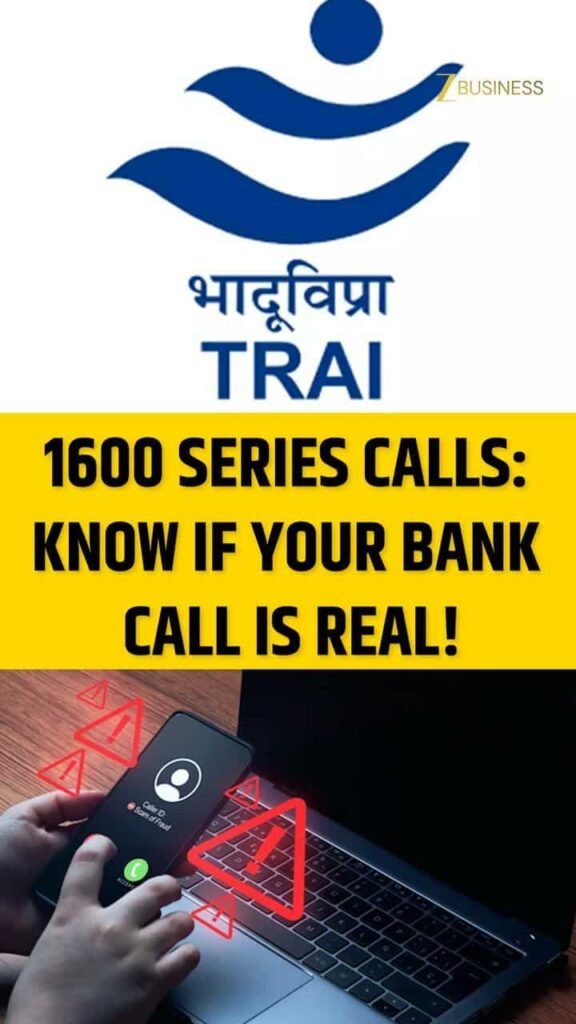TRAI Mandates ‘1600’ Number Series for Banking and Financial Calls: Deadlines Set to Curb Fraudulent Impersonation”
The Telecom Regulatory Authority of India (TRAI) has mandated that financial institutions, including banks, NBFCs, mutual funds, and pension funds, transition to the “1600” number series for all service and transactional calls by early 2026.
The move is designed to combat impersonation-based fraud and increase customer trust by making it easier to identify legitimate calls from regulated entities. The Department of Telecommunications (DoT) allocated the 1600 series specifically for this purpose.
A phased implementation is required for financial entities to adopt the 1600 number series. Deadlines for transition vary by institution type, beginning with commercial banks by January 1, 2026, and extending to others like large NBFCs, mutual funds, and smaller entities in the following months, concluding with Qualified Stockbrokers by March 15, 2026.
This change means legitimate calls from these institutions will originate from a 1600 number, helping customers distinguish them from potential fraud using standard mobile numbers.
In a decisive move to strengthen consumer trust and curb frauds over the phone, the Telecom Regulatory Authority of India (TRAI) has issued a firm mandate: all banking and financial services institutions must migrate their service and transactional calls to a dedicated “1600” numbering series. This shift, scheduled to take place through early 2026, is aimed at helping customers more reliably identify legitimate calls — and avoiding falling prey to impersonation-based scams.
Why TRAI Is Making This Change:
Tackling Fraud and Impersonation: Fraudsters often spoof or use random 10-digit numbers to impersonate trusted financial institutions. TRAI believes that a dedicated, regulated numbering series will greatly reduce this risk.
Enhancing Consumer Trust: With calls coming from a recognizable “1600” prefix, people can more confidently distinguish genuine service or transactional communications from potentially malicious ones.
Regulatory Backing: The “1600” series was specifically allocated by the Department of Telecommunications (DoT) for regulated financial organizations (BFSI) and government bodies, giving weight to this direction.
What the Deadlines Are — Who Needs to Do What, and When:
TRAI has laid out a phase-wise timeline for different categories of financial institutions. Here’s a breakdown:
Type of Institution Deadline for Switching to 1600 Series
Commercial Banks (public, private, foreign) from 1 January 2026
Large NBFCs (assets > ₹5,000 crore), Payments Banks, Small Finance Banks from 1 February 2026
Remaining NBFCs, Co-op Banks, Regional Rural Banks, Smaller Entities from 1 March 2026
Mutual Funds and AMCs effective from 15 February 2026
Qualified Stockbrokers (QSBs) from 15 March 2026
Pension Fund Managers and Central Recordkeeping Agencies (CRAs) from 15 February 2026
The Bigger Picture: What This Means for Consumers:
1. Easier Call Verification: When you see a call starting with “1600,” you can be more confident it’s from your bank, mutual fund company, or another regulated financial institution ,not a scammer.
2. Reduced Spam and Unwanted Solicitations: By restricting legitimate service-transactional calls to a specific number range, regulators hope to limit fake marketing pitches masked as official calls.
3. Strengthened Accountability: As more entities migrate, there will be greater regulatory oversight over number utilization, making it easier to track misuse and penalize offenders.
4. Gradual Transition: Since TRAI has given staggered deadlines, larger organizations have more time to migrate, and smaller players will follow soon after — reducing risk of implementation bottlenecks.
Challenges and Considerations:
Implementation Overhead: For financial institutions, migrating to the 1600-series means operational changes: reprogramming IVR, notifying customers, updating communication templates, and working with telecom operators.
Customer Awareness: The effectiveness of this move depends on customers understanding what “1600” means — widespread awareness campaigns will be necessary.
Enforcement Concerns: While deadlines are clear, enforcing compliance across hundreds of entities may be challenging. Regular monitoring and penalties for non-compliance will be key.
Insurance Sector Delay: Since the insurance sector’s timeline is not yet finalized, fraud risk may continue in that area until their migration is enforced.
What’s Next:
Consumers should start paying attention to “1600” prefix calls and treat them with more trust, but still stay vigilant (no system is foolproof).
Financial Institutions need to begin (or accelerate) their technical migration, engage with telecom partners, and communicate the change to customers.
Regulators and Telecom Operators will need to monitor progress, flag non-compliance, and perhaps run education campaigns.
TRAI’s mandate to move all BFSI entities to a dedicated “1600” numbering series is a powerful step toward reducing impersonation-based financial fraud. By setting firm deadlines, the regulator is pushing both large and small financial institutions toward a safer, more transparent calling system — one that helps customers more reliably identify genuine calls. While challenges lie ahead in terms of implementation and awareness, if executed well, this shift could significantly tighten the fraudsters’ window of opportunity and strengthen trust in voice-based financial communications
Team: Credit Money Finance

